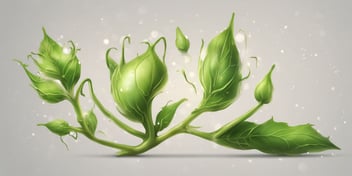- Blog
- Christmas trees
- Start from Scratch: Growing Your Own Christmas Trees from Seedlings

If you've ever dreamt of a picture-perfect Christmas straight out of a festive movie, complete with a beautifully decorated tree that you lovingly nurtured from its very beginnings, then you're in for a treat. Skip the pre-cut trees this year and embark on a delightful journey of growing your own Christmas trees from seedlings.
With a little patience, a touch of green thumb, and a sprinkle of holiday magic, you'll not only create cherished family memories but also contribute to a more sustainable, earth-loving celebration. So, grab your gardening gloves, dust off those trowels, and join us as we uncover the secrets to starting from scratch and cultivating your very own Christmas arboreal masterpiece.
Overview of Growing Your Own Christmas Trees from Seedlings
- Growing your own Christmas trees from seedlings offers a rewarding and sustainable way to celebrate the holiday season.
- By starting with seedlings, you have control over the entire growth process, ensuring healthy and beautiful trees.
- It allows you to select the specific variety of Christmas tree that suits your preferences and market demands.
- Cultivating seedlings provides economic benefits by reducing costs and increasing profits compared to purchasing mature trees.
- Environmental benefits include practicing sustainable agriculture and preserving wildlife habitat.
- Choosing the right seedlings and preparing the planting site are crucial steps for successful growth.
- Planting techniques, proper care, and monitoring growth will help your Christmas trees seedlings thrive.
- Harvesting and selling require careful timing and effective marketing strategies.
In short, growing your own Christmas trees from seedlings gives you the opportunity to create a unique and environmentally-friendly holiday tradition while enjoying economic benefits and control over the entire process.
Benefits of Growing Christmas Trees from Seedlings
Economic Benefits
One of the significant economic benefits of growing Christmas trees from seedlings is the reduced cost involved. By starting from scratch, you eliminate the need to purchase fully grown trees, which can be a significant expense for tree farmers. Instead, investing in seedlings allows for lower initial costs while still yielding profitable returns in the long run.
Additionally, growing your own trees gives you control over the quality and appearance of the final product, allowing you to cater to specific market demands and potentially command higher prices. This self-sustaining approach can lead to increased profits and a more sustainable business model.
Reduced Cost
Reducing cost is a significant advantage of growing Christmas trees from seedlings. By starting with seedlings rather than purchasing fully grown trees, you can save money on initial investment. Seedlings are more affordable and readily available from nurseries or online suppliers.
Additionally, growing your own seedlings requires minimal upkeep costs compared to buying mature trees. With proper care and maintenance, these seedlings can flourish into marketable Christmas trees, allowing you to maximize your profits without incurring substantial expenses. This cost-effective approach makes growing Christmas trees from seedlings a financially viable option for both small-scale and commercial growers.
Increased Profits
Increased profits are a significant advantage of growing Christmas trees from seedlings. By starting from scratch, you have the potential to reduce costs significantly compared to purchasing fully grown trees. This cost-saving can contribute to higher profits when selling the trees during the holiday season.
Additionally, growing your own seedlings allows you to control the quality and health of the trees, which can attract customers and command higher prices. With careful planning and efficient management, maximizing profits becomes achievable through the process of nurturing and selling Christmas trees seedlings.
Environmental Benefits
Planting Christmas tree seedlings has significant environmental benefits. By growing your own trees, you contribute to sustainable practices and reduce the demand for trees harvested from natural forests. This helps conserve wildlife habitats and maintain biodiversity. Growing Christmas trees also improves air quality by absorbing carbon dioxide and releasing oxygen.
Additionally, plantation forests can act as windbreaks, preventing soil erosion and protecting nearby ecosystems.
Sustainable Practice
Sustainable practice is a fundamental aspect of growing Christmas trees from seedlings. By adopting sustainable methods, you contribute to the long-term health of your trees and the environment. Implementing practices such as organic fertilizers, integrated pest management, and responsible water usage reduces the environmental impact.
For example, using compost instead of synthetic fertilizers enhances soil fertility while minimizing water pollution. By preserving the natural habitat around your seedlings, you provide shelter for beneficial insects and wildlife, ultimately creating a balanced ecosystem. By adopting sustainable practices, you ensure the longevity and success of your Christmas tree farm while minimizing negative impacts on the environment.
Preserving Wildlife Habitat
Preserving wildlife habitat is an important aspect of growing Christmas trees from seedlings. By implementing sustainable practices, such as avoiding excessive use of pesticides and herbicides, you can create a welcoming environment for birds, insects, and other small animals. Maintaining diverse vegetation around your tree farm encourages biodiversity and provides food and shelter for wildlife.
For example, planting native flowering plants or leaving areas undisturbed can attract beneficial insects and pollinators to the area. By considering wildlife habitat in your tree farming practices, you can contribute to the overall health of the ecosystem while still growing beautiful Christmas trees.
Choosing the Right Seedlings
Varieties of Christmas Trees Seedlings
When it comes to Christmas tree seedlings, there are various varieties to choose from. Some popular options include the Fraser fir, Balsam fir, and Douglas fir. Each variety has unique characteristics like needle color, scent, and needle retention. For instance, the Fraser fir is known for its excellent needle retention and pleasing aroma. The Balsam fir has a vibrant green color and soft needles. The Douglas fir is favored for its bushy appearance and hardiness.
Considerations for Climate and Soil
- The right climate and soil conditions are vital for successful growth of Christmas tree seedlings.
- Optimal climate conditions depend on the tree species you choose to grow, as some thrive in cooler climates while others prefer warmer regions.
- Pay attention to factors such as temperature ranges, precipitation levels, and frost dates to ensure compatibility with your chosen tree variety.
- Soil quality plays a crucial role in supporting healthy growth. Proper drainage, pH levels, and nutrient content are important factors to consider.
- Conduct a soil test to determine its composition and make necessary amendments, such as adding organic matter or adjusting pH levels, to create an ideal growing environment for your Christmas tree seedlings.
Preparing the Planting Site
Soil Preparation
Soil preparation is vital for the successful growth of Christmas tree seedlings. Start by clearing the planting area of weeds, rocks, and debris to provide a clean environment. Loosen the soil using a garden fork or tiller to promote good root development. Adding organic matter, such as compost or well-rotted manure, improves soil fertility and drainage. Conduct a soil test to determine pH levels and nutrient deficiencies, allowing you to make necessary amendments.
For example, lime can be added to raise pH levels if needed. Ensuring the soil is well-prepared creates optimal conditions for healthy root growth and overall tree growth.
Sunlight and Wind Factors
Sunlight and Wind Factors for Christmas Trees Seedlings:
- Adequate sunlight is crucial for the healthy growth and development of Christmas tree seedlings.
- Choose a planting site that receives at least 6 hours of direct sunlight per day.
- Avoid areas with excessive shade or areas prone to strong, damaging winds.
- Strong winds can cause stress and damage to young seedlings, affecting their growth.
- Consider planting windbreaks or wind barriers, such as fences or shrubs, to protect the seedlings from excessive wind exposure.
- Regularly monitor the wind patterns in your area to better adapt protective measures for the seedlings.
- Providing the optimal balance of sunlight and protection from wind ensures better chances of success in growing your own Christmas trees from seedlings.
Planting and Caring for Christmas Trees Seedlings
Planting Techniques
Planting Techniques for Christmas Trees Seedlings:
- Choose an appropriate location: Select a well-drained area with sufficient sunlight for optimal growth.
- Prepare the soil: Ensure the soil is loose and free from weeds, rocks, or other debris that may hinder the seedlings' root development.
- Dig the planting hole: Make a hole slightly larger and deeper than the container or root ball of the seedling.
- Place the seedling: Gently remove the seedling from its container and position it in the hole, ensuring the top of the root ball is level with the ground.
- Backfill and firm the soil: Fill the hole with soil, avoiding air pockets, and firmly press down to provide stability.
- Water thoroughly: Give the seedling a deep watering, making sure the soil around it is adequately moist.
- Mulch the base: Apply a layer of organic mulch around the base of the seedling to retain moisture and suppress weed growth.
Remember, proper planting techniques play a vital role in establishing healthy Christmas tree seedlings and laying the foundation for successful growth.
Watering and Fertilization
Watering and fertilization are important for the healthy growth of Christmas tree seedlings. Proper watering helps ensure that the roots receive adequate moisture without drowning them. It is recommended to water deeply and less frequently, allowing the soil to dry out slightly in between waterings. Adding organic mulch around the seedlings can help retain moisture. When it comes to fertilization, a balanced slow-release fertilizer can provide essential nutrients for tree development.
It's crucial to follow the recommended application rates to avoid over-fertilization, which can harm the seedlings. Monitoring the growth and health of the seedlings can guide adjustments in watering and fertilization practices.
Weed Control and Mulching
Weed control and mulching are important practices for maintaining healthy Christmas trees seedlings. Here are some tips for effective weed control and mulching:
- Clear the area around the seedlings of any existing weeds before planting.
- Apply a layer of organic mulch, such as wood chips or straw, around the base of the seedlings. This helps to suppress weed growth and retain moisture in the soil.
- Regularly inspect the planting site and manually remove any weeds that may emerge.
- Avoid using chemical herbicides near the seedlings, as they may harm their growth.
- Reapply mulch annually to maintain weed suppression and moisture retention.
By implementing these practices, you can ensure that the Christmas tree seedlings are given the best chance to thrive and minimize competition with invasive weeds.
Protection against Pests and Diseases
To protect Christmas tree seedlings from pests and diseases, regular monitoring and preventive measures are necessary. Inspect the trees regularly for signs of infestation or disease, such as discoloration or wilting. Implement cultural practices like removing nearby weeds and ensuring proper spacing between trees to minimize pest activity. Applying organic insecticides and fungicides can help control common pests and diseases, such as aphids or needle blight.
Additionally, beneficial insects like ladybugs can be introduced to control aphid populations naturally. By being proactive and taking timely action, you can prevent potential damage and ensure the health of your Christmas tree seedlings.
Monitoring Growth and Pruning
Measuring Growth
Measuring the growth of your Christmas tree seedlings is an important step to monitor their progress and ensure healthy development. One way to measure growth is by keeping track of their height using a measuring tape. Another method is to measure the diameter of the trunk, which indicates the tree's overall thickness. By regularly measuring these factors over time, you can assess the growth rate and make necessary adjustments to care and maintenance practices.
Remember to record these measurements in a logbook or digital spreadsheet for easy reference and comparison in future seasons.
Proper Pruning Techniques
Proper pruning techniques are important for the healthy growth and shape of your Christmas tree seedlings. Regular pruning helps to develop a desirable conical form and ensures even branch distribution. Start by removing any competing or crossed branches to encourage a well-balanced structure. Trim back excessive growth, particularly on the leader, to prevent the tree from becoming too tall or spindly.
Additionally, remove any diseased or damaged branches to maintain overall tree health. Remember to sterilize your pruning tools between cuts to prevent the spread of diseases. By following these pruning techniques, you can help your Christmas tree seedlings grow into beautifully shaped trees for the holiday season.
Harvesting and Selling Your Christmas Trees
Determining the Right Time for Harvesting
Determining the right time for harvesting your Christmas tree seedlings is important to ensure optimal tree quality and marketability. Ideally, you should harvest when the trees have reached the desired height and shape for the market demand. This is usually achieved after a certain number of years of growth, depending on the tree species. One practical method to determine the right time is by visually inspecting the tree's needles and branches.
If the needles are firmly attached and have a healthy green color, and the branches are sturdy enough to hold ornaments, it may be time to harvest.
Additionally, you can also check the tree's overall growth rate and compare it to average growth rates for the specific species.
Marketing and Selling Strategies
- Utilize online platforms: Create an engaging website or online store where customers can browse and purchase Christmas tree seedlings conveniently.
- Leverage social media: Utilize platforms such as Facebook, Instagram, and Pinterest to showcase the quality of your seedlings, share planting tips, and engage with potential customers.
- Participate in local events: Set up a booth at farmers markets, holiday fairs, or community events to promote your Christmas tree seedlings and connect with local customers.
- Offer promotional discounts: Attract customers by offering limited-time discounts or bundle deals on bulk purchases of seedlings.
- Collaborate with local businesses: Establish partnerships with local nurseries, garden centers, or landscaping companies that can recommend your seedlings to their customers.
- Provide exceptional customer service: Respond promptly to inquiries, provide planting advice, and ensure customer satisfaction to build a loyal customer base.
Key takeaways
When it comes to Christmas trees, growing your own from seedlings can be a rewarding and environmentally-friendly endeavor. Starting from scratch allows you to have full control over the size, shape, and type of tree you desire. However, doing so requires careful attention to the needs of the seedlings, such as proper watering, placement, and protection from pests.
By starting early and providing the necessary care, you can watch your Christmas tree grow over the years and create a cherished holiday tradition.
Read On

The Art of Planting Christmas Trees: Tips and Techniques
The scent of freshly baked cookies fills the air, twinkling lights adorn every street corner, and...

How to Start your Own Christmas Tree Nursery: A Comprehensive Guide
Ah, the holiday season is upon us, and what better way to embrace the festive spirit than by...

Unveiling the Essential Christmas Tree Vitamins: Keeping Your Tree Healthy and Vibrant
'Tis the season to be jolly, and what better way to spread holiday cheer than with a beautifully...